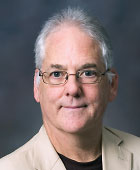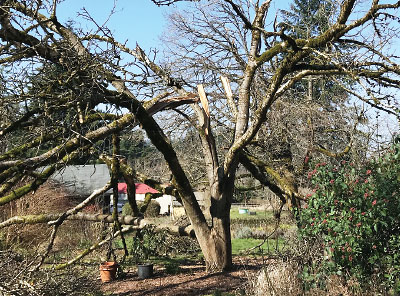Whither the Weather, Whether We Wither
Abstract

This account was written in mid-February, after a severe winter storm caused power outages across the United States, as far south as Texas. David Pollack, M.D., and his wife live in a rural area just south of downtown Portland, Ore.
The past six days have been harrowing because of a major weather event that began February 12. It deposited historic amounts of freezing rain, coating the trees and other plants with 1 to 2 inches of ice. The weight of ice led to overwhelming losses of branches and trees throughout the region, including our two-acre homesite. We lost electric power on the 12th. There are numerous power, Wi-Fi, and cable poles downed along nearby roads, so it is unclear when services will be restored.
The most frightening, depressing experience has been the severe damage to many mature trees surrounding our house and the rest of our land. Fortunately, none damaged any structures. The most grievous loss was the walnut tree we planted 44 years ago, the centerpiece of our backyard. It provided a canopy of shade, making a welcoming space for us to have meals and gatherings from spring through early fall. This magnificent tree seemed to have escaped the damage until Saturday afternoon, when a falling tree struck it like a domino, causing it to split and collapse with its huge branches falling in all directions. Heartsick witnessing this beloved companion fall apart, we were retraumatized when several more sections of the tree came down as the day progressed. The loss of many trees and branches is an aesthetic deprivation, but also reflects longer term impacts due to their lost carbon sequestration.
Greater problems emerged with our community water system. We serve on the board of the water system and have been preoccupied most of this time dealing with the loss of water to our customers. The power outage prevents us from pumping water from wells that provide water to our reservoir. Alerting customers to use water sparingly has been essential, but not everyone heeds our messages. In addition, at least two customers had major leaks that drained the reservoir before we could shut off their meters. Getting water delivered to the reservoir until power is restored or until we can get a generator to power the well pumps is another challenge. Fortunately, many neighbors are working collaboratively to help address these problems. The same issues affect the entire metropolitan area, so who knows how soon normalcy will return, irrespective of the massive cleanup required.

The severe weather event in February destroyed a beloved walnut tree that was planted 44 years ago in the backyard of David Pollack, M.D. The loss of the tree was particularly disheartening because it had sheltered many family gatherings.
Our property resembles a war zone with many branches scattered all around, covering our driveway, yard, and gardens. We cannot exit any doors of our home or drive our car without being blocked from easy egress by piles of large branches. Getting past the barriers, we walk extremely carefully due to treacherously slippery ice, and we avoid walking under the remaining trees that are erupting with showers of golf-ball-sized ice pellets or branches due to the thick ice coating. We hear loud cracks and crashes from falling projectiles day and night. Leaving will require days of cutting and removal of wood; this work cannot begin until the ice and snow melt and we get help to tackle the cleanup. As I write this, my thoughts are interrupted by incessant clattering of ice falling from trees, hitting our roof or sliding down the slanted windows of our attached greenhouse—ominous sounds and disturbing vibrations.
This is the third climate-derived weather event we’ve experienced since Labor Day. First was the freak windstorm on September 9 that created local wildfires (among the many wildfires throughout the Pacific Northwest) that almost forced our evacuation. The wildfires created eerie smoke-filled skies that ranged from gray to brown, red, and yellow, accompanied by the worst air quality in the world for a few days. Although we lost power for two days, the other hazards predominated.
Then, on January 12, our metropolitan area was victimized by an “atmospheric river”—an enormous collection of moisture carried high aloft, which dumped many inches of rain with accompanying winds, leading to power outages for Portland. With no power for about 40 hours, we came perilously close to losing the food stored in our freezer, most of which came from our garden.
This unprecedented onslaught of wind, fire, torrential rains, and ice is unequivocal evidence of climate disruption. Instead of feeling sorry for ourselves, which we are entitled to do, we’re more focused on folks who are less privileged and less well prepared for ever-increasing series of unusual events and hardships that we all experience in many ways at once. We’re concerned about those who lost so much during the pandemic—those who are housing insecure and are unable to feed or care for themselves or their families. We are mindful of how privilege has protected us from higher risks of harms that minority communities experience due to environmental racism, income inequality, and other social determinants of health. We’re particularly worried about children during these crises and whether they will develop a sense of hope and strength of vision to move forward through ever more stressful times. We have many challenges to face and must address them together as members of the larger community and as a society that provides for the health and well-being of all its members, come hell and/or high water.
Postscript
After four days, the weather cleared and temperatures rose, so the ice melted and cleanup proceeded. We were delayed in addressing the devastation around our home because of the water crisis: no water for 90 homes. Six days into the crisis, the power was finally restored to some of the areas around us, including our home, but not to the pumphouse for our water system, so we rented a generator to power the pumps to fill the reservoir and get water to everyone. It was many more days before power in that area was restored. A neighbor came with his tractor and chainsaw and helped us cut up wood and create piles of branches that will be chipped up at a later date. The degree of social cohesion in our community is encouraging, and we all are thankful for the kindnesses we share and receive. We are lucky but definitely more wary of future hazards, acute and prolonged. ■



